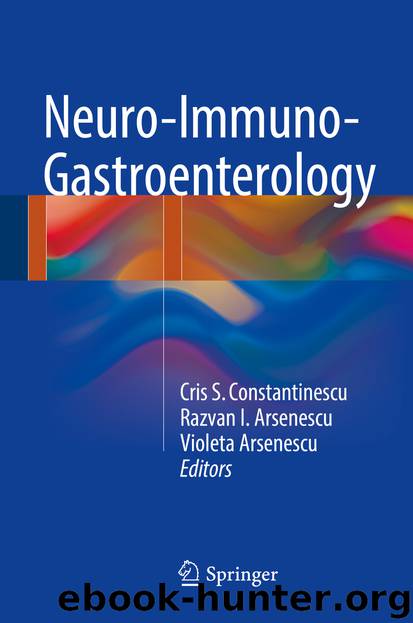Neuro-Immuno-Gastroenterology by Cris Constantinescu Razvan Arsenescu & Violeta Arsenescu

Author:Cris Constantinescu, Razvan Arsenescu & Violeta Arsenescu
Language: eng
Format: epub
Publisher: Springer International Publishing, Cham
Nutrient Effect on Gut-Brain Inflammatory Axis
The nutrient effect on central nervous system (CNS) function has been shown to be either direct via metabolites generated during digestion or indirect through complex interaction with gut microbiota and the gut-associated lymphatic tissue (GALT) (Fig. 8.1).
Dietary Metabolites: CNS Pathway
The blood-brain barrier assures selective transport of various dietary-derived compounds that circulate in the plasma. In general, the ability to diffuse across the barrier is a function of the lipid solubility, but molecules with low solubility will benefit from a carrier-mediated transport. Furthermore, vitamins and essential amino acids are not synthesized in the brain and require specific transport systems; their availability in the brain is dependent on the diet and could be limited by substrate competition [17].
Western diet has been associated with obesity epidemic and a rising incidence of autoimmune disorders [18]. Saturated fat has been linked to the development of MS [19] and restriction of animal fat may alter the disease course. The relative concentration of dietary polyunsaturated fatty acids (PUFA) can alter the outcome of chronic inflammation. N-3 fatty acids are found in plant oils (i.e., α-linolenic acid) and fish oils (i.e., EPA and DHA) and exert anti-inflammatory activity. On the other hand, excess of n-6 fatty acids (i.e., linoleic acid) may promote an inflammatory milieu by stimulating the production of arachidonic acid (AA) and downstream production of pro-inflammatory prostaglandins, leukotrienes, and thromboxanes. N-3 fatty acid-derived resolvins D1 and E1 can decrease microglial production of TNFα and IL-6 and, thus, mitigate neuroinflammatory conditions [20]. In an animal model of cuprizone-induced demyelination, n-3 PUFAs docosahexaenoic (DHA) and eicosapentaenoic (EPA) acids were able to reduce the neurodegenerative process and improve motor and cognitive functions [21]. Mechanistically, this was linked to decreased microglial production of interferon gamma (IFNγ), increased myelin phagocytosis, and a shift toward M2 phenotype. Similar protective activity was observed in vascular neurodegenerative disease models [22]. Several randomized control studies have addressed the role of n-3 PUFAs (EPA and DHA) in patients with multiple sclerosis [23, 24]. Until now, there was no significant effect on MRI disease activity, rate, or severity of relapses. All studies used comparable daily doses of EPA and DHA.
Molecular mimicry between host and microbial components may lead to pathological activation of the immune system. A study in children with central nervous system (CNS) inflammatory demyelination revealed autoreactive T cells, as well as abnormal T cell responses against multiple cow-milk proteins [25], such as butyrophilin (BTN). Interestingly, butyrophilin resembles the MS autoantigen, myelin oligodendrocyte glycoprotein (MOG). In a rat model of EAE, BTN administration resulted in accumulation of meningeal and perivascular infiltrates of T cells and macrophages throughout the brain [26]. Furthermore, MOG-specific T cells that were activated by exposure to BTN or/and transfer of BTN-induced T cells, reacted to MOG antigen, thus proving the molecular mimicry mechanism. Based on clinical and preclinical studies, MS patients may choose to refrain from consuming cow’s milk, a rich source of BTN. On the other hand, this cross-reactivity with the MS-putative antigen may be exploited
Download
This site does not store any files on its server. We only index and link to content provided by other sites. Please contact the content providers to delete copyright contents if any and email us, we'll remove relevant links or contents immediately.
| Administration & Medicine Economics | Allied Health Professions |
| Basic Sciences | Dentistry |
| History | Medical Informatics |
| Medicine | Nursing |
| Pharmacology | Psychology |
| Research | Veterinary Medicine |
Periodization Training for Sports by Tudor Bompa(8170)
Why We Sleep: Unlocking the Power of Sleep and Dreams by Matthew Walker(6618)
Paper Towns by Green John(5089)
The Immortal Life of Henrietta Lacks by Rebecca Skloot(4525)
The Sports Rules Book by Human Kinetics(4290)
Dynamic Alignment Through Imagery by Eric Franklin(4116)
ACSM's Complete Guide to Fitness & Health by ACSM(3989)
Kaplan MCAT Organic Chemistry Review: Created for MCAT 2015 (Kaplan Test Prep) by Kaplan(3939)
Introduction to Kinesiology by Shirl J. Hoffman(3725)
Livewired by David Eagleman(3683)
The Death of the Heart by Elizabeth Bowen(3551)
The River of Consciousness by Oliver Sacks(3536)
Alchemy and Alchemists by C. J. S. Thompson(3449)
Bad Pharma by Ben Goldacre(3355)
Descartes' Error by Antonio Damasio(3230)
The Emperor of All Maladies: A Biography of Cancer by Siddhartha Mukherjee(3064)
The Gene: An Intimate History by Siddhartha Mukherjee(3047)
The Fate of Rome: Climate, Disease, and the End of an Empire (The Princeton History of the Ancient World) by Kyle Harper(3003)
Kaplan MCAT Behavioral Sciences Review: Created for MCAT 2015 (Kaplan Test Prep) by Kaplan(2936)
